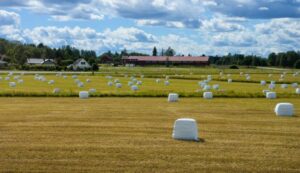Bales wrapped in net wrap are more durable than those tied with twine. It helps protect bales during transport and storage, as well as preventing theft or vandalism.
Strength and Durability
 Bales wrapped with heavy-duty net replacement film are more robust than those covered in traditional net wrap and can withstand greater handling during transportation. It means they are less likely to suffer from damage, such as mould or breakage, that could compromise silage quality. The extra layer of film on the barrel of the bale also improves the oxygen barrier and helps to reduce silage losses during storage.
Bales wrapped with heavy-duty net replacement film are more robust than those covered in traditional net wrap and can withstand greater handling during transportation. It means they are less likely to suffer from damage, such as mould or breakage, that could compromise silage quality. The extra layer of film on the barrel of the bale also improves the oxygen barrier and helps to reduce silage losses during storage.
Another benefit of heavy-duty net replacement film is that it does not sag like the older style of net wrap, which can leave weak spots on the bale. It can affect the overall strength of the bale and allow for fodder to protrude from the net, which could cause loss of valuable feed.
This newer technology is pre-stretched to strengthen it during production and is easier to apply. It means fewer roll changes for the baler, reducing downtime and allowing for more on-site productive time. It is also compatible with most newer combination baler/wrapper units, such as the McHale Fusion 3 Plus.
The inner baling film and outer silage wrap are made of the same industry films or plastic materials, which makes it easier to sort for recycling compared to net wrapping, where it is often difficult to separate the fine web-like netting from the actual plastic and fodder packaging. That will further cut down on waste and make the process more efficient.
Oxygen Barrier
Bales wrapped with heavy duty net replacement film can withstand more handling than those covered with older-style net wrap. It means that they are less likely to be misshapen during transportation, which can cause problems with the fermentation process and result in loss of quality hay. It also helps the bales to stay more compact and cylindrical, which reduces oxygen permeation during storage. It is a particularly important benefit when the bales are stored outdoors, as it can help to avoid the problems that can happen with overly-compacted, misshapen bales.
The net replacement film is designed to be used with newer combination round balers, which make the wrapping process much easier. It’s pre-stretched to strengthen its film properties, meaning that it wraps tightly around the bales and stays in place without slipping. It reduces the amount of time and labour that is needed, which can save farmers valuable work hours.
The material that is used to produce this heavy duty net replacement film is a thicker plastic than the old net wrap, and it can withstand more stress. It is also more difficult to tear or puncture, which makes it a more secure choice for protecting your bales. It can help to prevent theft and vandalism, as well as to keep vermin and animals from damaging the feed inside the bales.
Moisture Barrier
Bales wrapped with net replacement film are much less likely to damage and misshape during transportation. It allows them to be stored for longer periods, leading to better quality hay and reduced risk of mould.
The opacity of the film also reduces mould and vermin damage on your bales and makes it more difficult for them to see what’s inside. It leads to a more robust bale and increased profitability.
This innovative option is designed for use with the latest fleet of combination baler/wrapper units. The film adds extra layers of plastic sealing around the barrel of the bale, improving the oxygen barrier and allowing for better storage of hay, reducing mould and preventing vermin damage.
Unlike the older style of net wrap, which can develop weak spots, this type of heavy duty net replacement film doesn’t allow the main threads to break and protrude from the bale. It means that the integrity of the bale is maintained, and it has a stronger overall structure, which also makes it easier to apply a secondary silage wrap after ensiling.
The high tensile strength of the film ensures that it is not easily punctured and ripped, even by larger animals or machinery. It is also easier to sort when recycled than traditional net wrap, which makes it environmentally friendly.
